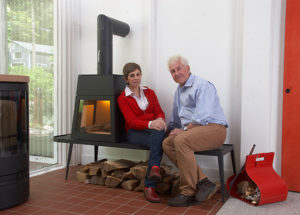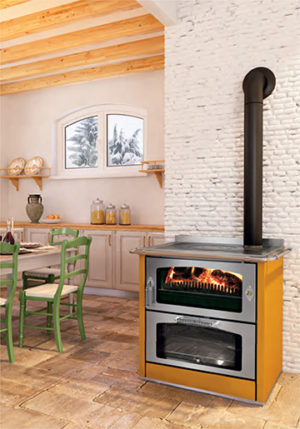Wittus Is All Fired Up

Nestled along Westchester Avenue in Pound Ridge, you”™ll find a place that sells stoves. Not your induction hobs and gas cooktops, not even your pot-bellied wood-burning stoves of yore, but sleek, sexy stoves for the modern home.
The building ”” which can fairly be described as a low-slung, wooden chalet, with its floor-to- ceiling windows and cheerful line of flags outside ”” would not look out of place in an Alpine resort or Scandinavian village. And that”™s fitting since it”™s the headquarters of Wittus: Fire by Design, the country”™s leading importers of quality European-designed and manufactured hearth products.
The business began life as a fledgling company in 1978, when Niels Wittus found himself unexpectedly having to dispose of a consignment of wood-burning stoves. His late father, Per Wittus, had been trying to offload the stoves to an American importer, but the deal fell through. Niels, who had arrived in the United States from his native Denmark four years earlier and was working in real estate, stepped into the breach, and Wittus: Fire by Design was born.
Niels still heads the company, with Alyce, his wife, as vice president. The pair are passionate not only about their products but about the idea of incorporating fire into the home”™s design in keeping with the Danish concept of hygge or coziness, which has been gaining importance worldwide.
Pre-pandemic, the Wittuses would attend trade shows in Verona, Italy; in Harrogate, United Kingdom; and in Frankfurt, Germany, home of the ISH fair on water management.
Working mainly with builders and architects but also directly with retail clients, they sell their gas and wood-burning stoves, fireplaces and accessories either straight from their showroom or through a network of around 120 dealers nationwide.
The products include such best-selling wood-burning stoves as the Klassic, created in 1970 by industrial designer Bend Falk; the Shaker ”” inspired by American Shaker furniture and designed by Italian architect Antonio Citterio; and the Stack and Rondó, made in Italy by La Castellamonte, known for its ceramics, and designed by Adriano Design Studio.

Courtesy Wittus.
Niels is a great believer in advertising such wares, an ongoing exercise that has served the company well. After early success in taking on dealers for the company”™s products, he says, those products were nevertheless difficult to sell. “Then we ran some of our first ads in Metropolis (the market-leader design magazine) and the business just exploded.” In the last 20 years, the internet has totally transformed the business, he adds. “Back in the old days, we used to send out 30,000 catalogs ”” physical catalogs, me typing labels on an old (Smith) Corona. Imagine. And they were not small envelopes.”
The company is also active on social media, which is another area the two think important. (The Chicago-born Alyce was in marketing and with IBM.) Recently, the Wittuses hired somebody just to take care of their Instagram account and other platforms. There, as in the showroom, terminology is key.
“Do we sell wood stoves? Yes,” Niels says. “But when you say to someone who is not familiar with our designs, ”˜We sell wood stoves,”™ they say, ”˜Oh, but I don”™t want a wood stove. My grandmother had one and it was a stupid little thing and it was also dirty.”™” So instead, Wittus prefers to say he sells contemporary fireplaces, or what he terms “warm furniture” that combines up-to-date, automated manufacturing techniques with a high element of craftsmanship.
Who buys Wittus stoves and fireplaces? Just about everybody, it would seem. The late design writer Phil Patton expressed this in a profile of Wittus he wrote for Esquire magazine in 1989, describing how Wittus could be found “in SoHo lofts, Chicago industrial conversions, Fire Island cottages and Aspen condos.” And that holds true today, although the reach is perhaps even wider, with Wittus selling its products all over the country as well as in the far reaches of Canada.
“Clients are generally over 40,” Niels says. “For one thing, before you buy a stove or fireplace, you actually need to have a house.” He also mentions that Wittus clients tend to be well-traveled and to have had some exposure to European design. He and Alyce feel that American taste can be by and large a little conservative, and they see themselves as influencing it to some extent.
Most of the clients, Niels says, use the product as a real focal point. After all, these stoves and fireplaces are not only aesthetically pleasing; they are literally the “focus” ”” Latin for “hearth” ”” of a kitchen or another room. They are also completely compatible with, and even corroborate, our increasingly eco-minded society. EPA-certified and environmentally friendly, Wittus-supplied products burn cleanly and efficiently, with adjustable air controls and other refinements. Yet even the most expensive stoves and fireplaces have a pleasing simplicity of design and timeless quality so that what you choose today will still look good a half-century on.
Prices for Wittus: Fire by Design products range from $3,500 to $15,000. For more, visit wittus.com.